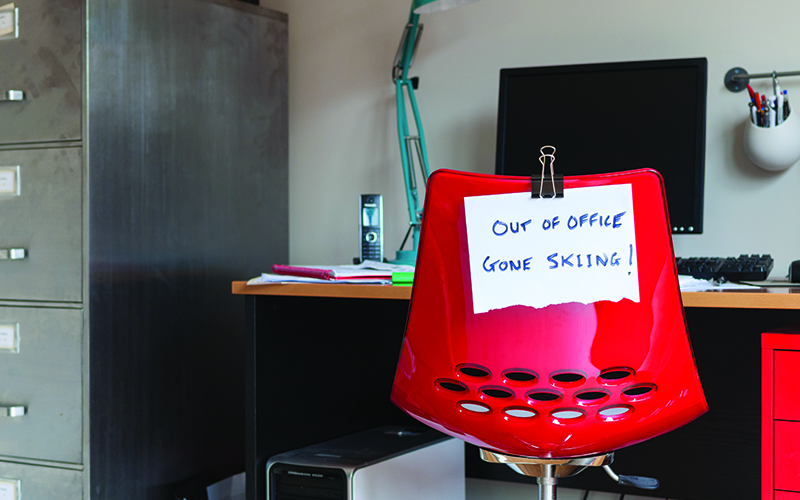Avant-garde HR
Three innovative ways to boost employee morale and send productivity through the roof.
By Selena Chavis | Winter 2016/17

As the concept of work-life balance is increasingly mainstreamed into the American psyche, the business community is responding in kind—think shorter workdays and work weeks, and paid time off to travel the world. The ROI these innovative approaches are seeing might just have you thinking outside the box as well.
Month-long sabbaticals
Sarah Shepard, a partner in Plante Moran’s Chicago office, took her first paid, month-long sabbatical in early 2016. She kicked it off with a trip to New Zealand, where she spent 10 days exploring North Island with her husband. Then came Florida’s Walt Disney World with her 10-year-old niece. Next up, some R&R on West Palm Beach. To wind it all down, a girls’ trip to Scottsdale, Ariz.
It might sound like Shepard has it made, but sabbaticals—and many other forward-thinking HR tactics—increasingly are being used to recruit, retain and motivate today’s top talent.
“One of the more obvious benefits of the sabbatical program is that it prevents partners from becoming burned out, but it really goes further than that––it’s an important step to succession planning,” Shepard contends. “When we take a sabbatical we have to relinquish control; we have to transition our work and prepare the right people to take over in our absence. It teaches partners to train and develop staff, and gives staff an opportunity to step up and manage a client relationship.”
Plante Moran began its program in 2001, offering partners a paid sabbatical of 30 consecutive days every five years, explains Chicago office Managing Partner Tom Kinder. “The time is to be used for rest, relaxation and renewal. Contact with the firm and clients during this time is highly discouraged,” he says.
If you think Plante Moran is an anomaly, then let me tell you that Deloitte and Goldman Sachs also see the merits of sabbaticals. Could your firm or company be next?
Five-hour workdays
Stephan Aarstol, CEO of Tower Paddle Boards, believes that a lot of time is wasted in today’s offices. Aiming to shed dead weight and foster an entrepreneurial work ethic, he devised a five-hour workday. The outcome? Greater productivity, higher employee morale and an improved bottom line.
“It was a very capitalistic undertaking,” Aarstol admits. “I wanted to keep good people—specifically the people in every office that worked three times the speed of everyone else. I wanted to attract those people and repel all the others.”
It’s not a new concept. History has proven that smart use of technology and productivity tools can have an enormous, positive impact, says Aarstol. Think Henry Ford and his introduction of an assembly line—productivity increased substantially, profits doubled in two years, and within seven years he managed 61 percent of the worldwide car market.
Tower Paddle Board employees work from 8 a.m. to 1 p.m. straight through with no lunch, and are expected to leverage the tools available to them to do their jobs faster—and exceptionally well. Essentially, Aarstol told them, “You need to be as productive as before, and if you can’t, you’ll be fired.”
“What are we doing in America? We’re working longer and longer hours. And everyone is measured by what time you get in and what time you leave, and that’s how you get promoted,” he says. “There are a lot of societal ills that come from this.”
Instead, Tower Paddle Board encourages employees to work and think more like entrepreneurs. “You get your head down and work. This is how I’ve been working for the past 10 to 15 years. To survive as an entrepreneur you have to be super productive. The people doing that are the ones driving today’s economy,” Aarstol insists.
Acknowledging that the five-hour workday doesn’t offer a lot of time for team bonding or socializing, the company compensates with regular after-work outings and two all-employee trips a year, like attending the Sundance Film Festival or hitting the beaches in Mexico.
What’s more, employees maintained their same salaries and gained a 5-percent profit share. That translated into employees who made $40K a year getting a bump to $48K—and hourly pay nearly doubled.
Four-day workweeks
Untraditional hours and flextime? At a Big Four firm? You bet—and they could be coming to an employer near you.
According to a 2014 study conducted by the Society for Human Resource Management, 43 percent of companies offer four-day workweeks to some employees, and 10 percent make it available to all or most employees.
“At KPMG, a four-day work week is just one option the company offers,” says Barbara Wankoff, executive director, diversity and inclusion. “We have a culture of flexibility which enables people to have some control over how and when they work. Often it allows us to retain a contributing member of our workforce that the company has invested in for the long term, but who needs a modified schedule or workload for a period of time.”
Interested employees approach their People Management Leaders (PMLs) to request an adjusted work schedule. PMLs play a robust role beyond performance management consultation to provide career development, work-life balance advice, resource management and networking guidance for employees.
“We know flexibility is tied to morale,” Wankoff explains. “When people feel they are able to manage their personal and professional responsibilities, they are happier and more effective all around.
“We look at careers over the long-term—not for any one period of time,” Wankoff adds. “It’s about good communication between the individual and their PML to manage their work on the days they are scheduled, as well as on the days they are off.”
So, what’s stopping you from thinking outside the box, raising morale and boosting productivity?